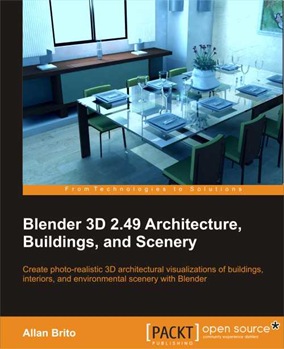 Blender is one of the most popular open source and free 3D creation suites.
Blender is one of the most popular open source and free 3D creation suites.
Many professionals use Blender in their daily work, for architecture, movies, or 3D modeling and animation in general.
Blender is a very powerful tool that can give you professional results with no cost. But learning how to use it is not easy for everyone.
This book, "Blender 2.49 3D Architecture, Buildings, and Scenery", by Allan Brito, comes to solve this problem.
Written in understandable language, makes using Blender simple and easy.
Albeit the author tells us that this is not an introductory book to Blender, the fact is that someone that is not familiarized with it at all can read the book, follow what it says and end being a skilled modeler.
Modeling inorganic shapes is an excellent way to master 3D modeling. And this book can give you all the keys for doing it as a professional.
Its author is Allan Brito, a Brazilian architect specialized in information visualization that works with Blender to produce visualization and instructional material.
He teaches 3D modeling, animation and multimedia at Mauricio De Nassau College (Brazil).
This is a book that can be valuable for architects, game designers, 3D artists, and movie makers. But also for every 3D fan that wants to model, animate and render interiors, buildings, furniture, and much more.
It covers everything from modeling objects, cameras, exporting, optimizing, post-production retouch with the GIMP, lightning, texturing and materials, adding virtual humans to scenes and other objects to increase realism, developing your own libraries to work faster, use YafaRay to render photorealistic images of your works, animation, video-tours...

All this is teach through 14 chapters. Chapters 1-5 tell you how to build your own 3D models. You will learn how to use very specialized modeling tools that Blender has, like Loop Subdivide or Remove Doubles. Also, you'll master the proportional and precise editing of architectural models, even how to create curved walls on building interiors.

Chapter 6 tells how to add furniture models, giving you some Internet addresses where you can get reference images to use.
In chapters 7 and 8 you can learn how to apply materials and textures. There's even explanations on how to create glass material, and self-illumination.

Chapters 9, 10, 11 and 12 deal with rendering and lighting, teaching you things like UV mapping (attach a texture to particular portions of a 3D mesh), volumetric shadows, and radiosity.
Number 13 is about how to use camera and create animation and videos.

Finally, chapter 14 is a quick guide to post-production retouch of your rendered images in GIMP, the free image editor.
In addition, the publisher -Packt Publishing- pays a royalty to Blender project, so buying a book from Packt Publishing you are indirectly supporting the open source project of that book (in this case, Blender). This way, you help the developers by helping yourself.
There are two kinds of people that may find this book useful: the skilled user that wants to get the most of Blender when modeling architecture scenes, and the user that wants to start using Blender but also wants to reach a high level on these skills.
In both cases, this is a complete book that has all that you need.
Check it here:
© by Jordi R. Cardona. Link to this post without copying the text.
If you liked this post, get updates of Hiperia3D News for FREE






 Hiperia3D News is a Netbeans Community Partner, in recognition for developing the
Hiperia3D News is a Netbeans Community Partner, in recognition for developing the 


Be the first to comment!
Post a Comment